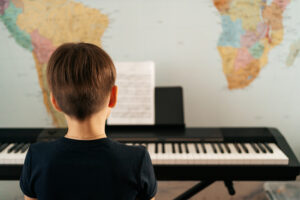As a team of private music teachers working with beginner students every day, we often get asked: What’s the difference between a piano and a keyboard? If you’re trying to decide which instrument to start with, understanding the differences between a piano and a keyboard is essential.
The good news? Both can be excellent choices for beginners—it just depends on your goals, space, and budget. Let’s break it down so you can make an informed decision that sets your student up for success.
The Key Differences Between a Piano and a Keyboard
While both instruments look similar and are played the same way, there are some important distinctions:
1. Size and Portability
- Piano: Large and heavy; not easily moved.
- Keyboard: Lightweight and portable; easy to store or travel with.
2. Key Action
- Piano: Weighted keys with real hammers, offering resistance that builds finger strength.
- Keyboard: May have semi-weighted or unweighted keys unless specified as fully weighted or “hammer action.”
3. Sound Production
- Piano: Acoustic sound created by felt hammers hitting strings.
- Keyboard: Digital sound sampled from real pianos (quality varies by model).
4. Price and Maintenance
- Piano: More expensive upfront; requires regular tuning and maintenance.
- Keyboard: Budget-friendly; no tuning required.
Which Is Better for Beginner Students?
For most beginners, especially young children or families with limited space, a keyboard with 88 weighted keys is a practical and effective starting point. It allows for proper technique development and mimics the feel of a real piano more closely than smaller, unweighted models.
However, if your child is serious about classical music or has consistent access to an acoustic piano, starting on the real thing can be a great choice too.
We help families evaluate their needs in more detail in our blog on how to prepare for your child’s first piano lesson.
For an in-depth look at digital keyboard types, Yamaha’s guide to digital pianos is a great resource.
FAQ: Piano and a Keyboard
Q: Can I learn to play piano on a keyboard?
Yes! As long as the keyboard has weighted keys and a full 88-key range, it’s a great learning tool.
Q: How many keys should a beginner’s keyboard have?
Ideally, 88 keys. But for very young beginners, 61 or 76 keys can be okay to start with—just plan to upgrade later.
Q: Is a keyboard loud?
It doesn’t have to be! Keyboards usually have volume controls and can be played with headphones, making them apartment-friendly.
